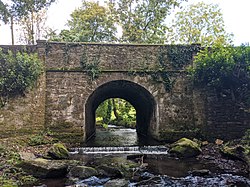Carrignavar
| Carrignavar Irish: Carraig na bhFear | |
| County Cork | |
|---|---|
 Carrignavar Bridge | |
| Location | |
| Grid reference: | W677820 |
| Location: | 51°59’20"N, 8°28’37"W |
| Data | |
| Population: | 519 (2016) |
| Postcode: | T34 |
| Local Government | |
| Council: | Cobh |
| Dáil constituency: |
Cork North-Central |
Carrignavar is a village in County Cork, north of the City of Cork. It stands to the east of Whitechurch and west of the R614 road, by a bridge over the Cloghnagash River.
The name of the village is from the Irish Carraig na bhFear, meannig 'The rock of the men'.[1][2])
History
A castle was built at Carrignavar by Donal or Daniel McCarthy, younger brother of the first Viscount Muskerry, of the MacCarthy of Muskerry family.[3][4] It was said to have been the last fortress in Munster to fall to Cromwell.[5] His descendants (surname variously spelt McCarty or McCartie) lived there into the nineteenth century,[4][6][7] though, by 1840, little more than a square tower remained.[5]
In the eighteenth century, Charles MacCarthy was a Jacobite sympathiser and patron of late Gaelic poetry; he and his poets converted, at least in form, from Roman Catholicism to the reformed Church of Ireland to escape the Penal Laws.[8]
Carrignavar House, a castellated country house, was built beside the castle ruins in the late nineteenth century.[6] John Sheedy bought it in the early twentieth century and later sold it to the Sacred Heart Fathers, who opened Sacred Heart College secondary school there in 1950.[6][9]
Outside links
References
- ↑ "Carrignavar". Placenames Database of Ireland. http://logainm.ie/9336.aspx. Retrieved 7 July 2012.
- ↑ Joyce, P. W. (1898). "The Irish Local Name System: Systematic Changes". The origin and history of Irish names of places. 1. London, New York: Longmans, Green and co.. p. 22. http://home.us.archive.org/stream/originhistoryof01joyc#page/22/mode/1up.
- ↑ "The Clann Carthaigh (continued)". Kerry Archaeological Magazine 3 (15): 206–226. October 1915.
- ↑ 4.0 4.1 Burke, John (1835). "M'Carty, of Carrignavar". A genealogical and heraldic History of the Commoners of Great Britain and Ireland, enjoying territorial possessions or high official rank, but uninvested with heritable honours. II. Colburn. pp. 610–11. https://books.google.com/books?id=0I9AAAAAcAAJ&pg=PA610. Retrieved 7 July 2012.
- ↑ 5.0 5.1 Samuel Lewis (1840). A topographical dictionary of Ireland comprising the several counties, cities, boroughs corporate, market, and post towns, parishes and villages ... : With an appendix describing the electoral boundaries of the several boroughs as defined by the act of the 2d. and 3d. of William IV.. Lewis. pp. 279. ISBN.
- ↑ 6.0 6.1 6.2 "Estate: McCartie (Carrignavar)". Landed Estates Database. NUI Galway. 17 May 2011. http://landedestates.nuigalway.ie:8080/LandedEstates/jsp/estate-show.jsp?id=2983. Retrieved 28 June 2012.
- ↑ O'Donovan, John (1841). "Additional Notes B: the descent of the MacCarthys". The Circuit of Ireland by Muircheartach Mac Neill. Tracts relating to Ireland. 1. translation of a poem by Cormacan Eigeas. Dublin: Irish Archaeological Society. p. 64. https://archive.org/stream/tractsrelatingto01irisuoft#page/64/mode/1up.
- ↑ Dickson, David (2004). "Jacobitism in Eighteenth-Century Ireland: A Munster Perspective". Éire-Ireland 39 (3): 38–99. doi:10.1353/eir.2004.0020. SSN 1550-5162.
- ↑ "About Us". Official website. Carrignavar: Coláiste an Chroí Naofa. Archived from the original on 23 August 2013. https://web.archive.org/web/20130823154636/http://colaisteanchroinaofa.com/index.php/about. Retrieved 7 July 2012.